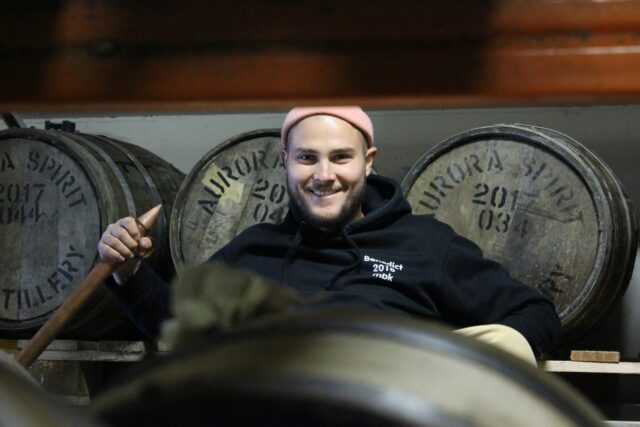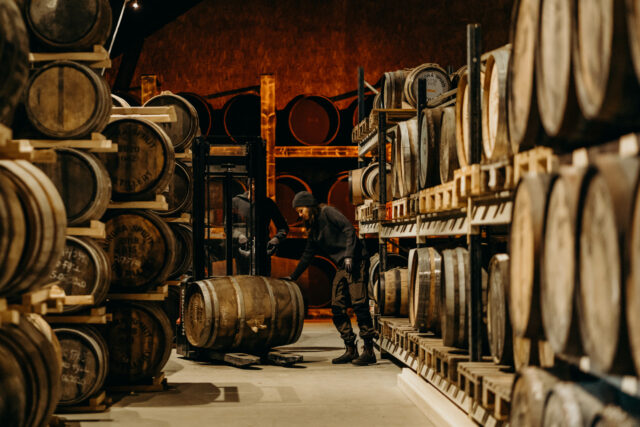“Barley was the most important grain in Northern Norway until the Second World War. It withstood the harsh climate”, says Mr. Benedict Skelton of the Norwegian Aurora Spirit.
”After the war other grains replaced it and barley fields disappeared from the Arctic scene.”
The Aurora Spirit Distillery is located in Lyngen, Northern Norway – Almost as high as the top of Finland. The company started distilling whiskey in 2017.
At beginning, the barley used, came from Finland.
 ”Shortly after that, we noticed a local farmer growing barley for feed. We ended up in a joint project, in which our aim was to produce the northernmost barley and whiskey malt in the world”, Skelton recounts the history.
”Shortly after that, we noticed a local farmer growing barley for feed. We ended up in a joint project, in which our aim was to produce the northernmost barley and whiskey malt in the world”, Skelton recounts the history.
The first task was to find a variety of barley which could withstand the harsh arctic conditions. After several trials, Héder-variety was selected. It has a very short growing season, suitable for the region. And this variety is also able to utilize arctic, round-a-clock sunlight.
”The weather here is windy and moist. Héder’s short and thick stalk can handle strong winds even if the plant is wet. It also ripens fast enough to be harvested before the first frosts, which normally occur in early September”, Skelton explains.
However, Héder is not the best possible variety for malting. Last year, Brage-variety also succeeded, and the plan is to try it this year as well. Brage is better for malting purposes than Héder.
Seamless traceability
Next we are going to present Golden Malt and FoodFarm from Finland.
”Converting barley into malt requires deep knowledge of biochemistry, and indeed, Héder is not the easiest variety to be malted. That’s why we contacted FoodFarm. They have impressive expertise and they own a small, batch-spesific malting equipment, which is just suitable for the needs of Aurora Spirits. This is the reason why we are sending our harvest to Finland for processing”, says Benedict Skelton.
The story behind the Northernmost Whiskey in the World is unique and its traceability is flawless. The exact harvest of barley that comes to this small maltery is sent back as malted to Aurora Spirit.
”Our current customers are a mix of whiskey enthusiasts and ordinary whiskey drinkers. We have not launched a brand of arctic-malt-based-arctic-whiskey yet, but when we do, it will be targeted mostly for the enthusiasts.”
Skelton believes, that the taste of the whiskey when ready, will be very different compared to other whiskeys in a positive manner. “By far, it is the Northernmost Whiskey in the World.” 
Malting in Batches brings many possibilities
The drum malting equipment is a combination of separate steeping tower, germination drum, heat/cooling/ventilation unit and automatized process equipment. The whole process is controlled by a computer.
“Specialty malts for the brewing, distilling and baking industries as well as germinated products for food industry can be produced with the drum malting equipment. The number of different recipies is almost limitless”, says Eero Nissilä, CEO of Golden Malt.
Drum malting equipment can also be used for pilot projects before entering any larger-scale production.
Equipment is easy to clean and disinfect thoroughly between batches. So, for example, it is risk free to produce germinated glutein-free products. In ordinary malterys this is not possible due to the barley contamination risk.
As the equipment is very scalable, it allows very clear and solid traceability and branding of the products. Mr. Nissilä gives couple of examples; Farm- of even field-specific traceability of the harvest and the Northernmost Whiskey in the World by Aurora Spirit Distillery.
Germination has a lot of benefits
In germination process, the flavor profile of the raw material improves, says Nissilä.
”There is a vast supply of germinated seed products in the world, where the main sales argument is taste. It is known, that the taste and mouthfeel of germinated product are felt as pleasant compared to non-germinated ones.”
During germination, the physical structure of the raw material changes and its processability improves. For example, if cooking vegetarian patties both from germinated and non-germinated fava beans, you’ll find a huge difference.
According to Nissilä, the third advantage of germination is, that in germination process, biological usability, availability, consistency and bioactivity of all the components within the raw material are changed.
”For example, the consistency of carbohydrates is changed, the availability of dietary fibers with certain raw materials gets significantly better, the structure of storage proteins and the consistency of amino acids is changed. And the amount of bioactive compounds, such as vitamins and antioxidants, increases. Growing tested and known variants combined with patch-specific targeted germination is the key thing here.”
